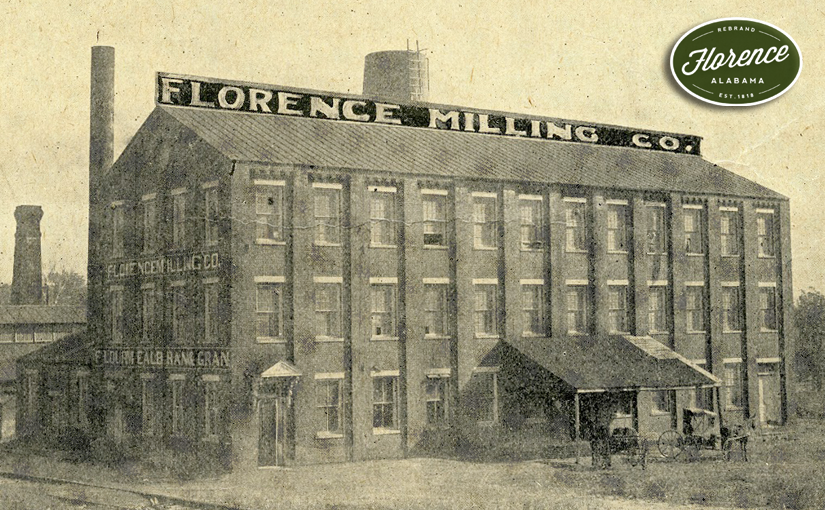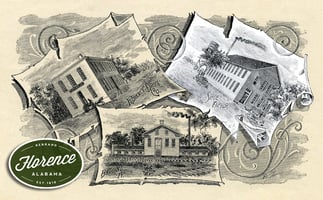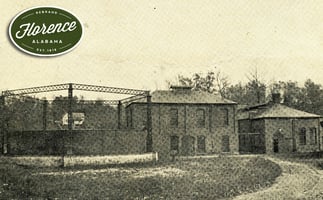REBRAND FLORENCE PARTNERSHIP Shoals History is excited to partner with the Rebrand Florence...
Florence Milling Company
REBRAND FLORENCE PARTNERSHIP
Shoals History is excited to partner with the Rebrand Florence Instagram project. Each company from Florence’s past that is rebranded through the Rebrand Florence project will have an associated post here on the Shoals History website. The first edition is the Florence Milling Company. Read more about what the Rebrand Florence project is doing. Some research and images are graciously provided through a partnership with the Florence-Lauderdale Public Library‘s Local History department.
Follow along with Rebrand Florence on Instagram, Twitter, and Facebook.
The Florence Milling Company
After working several years in the grain industry in Columbia, Tennessee, T. J. Rea, J.J. Fleming and T.J.’s son J.C. Rea. opened the Florence Milling Company’s doors for business on August 12, 1898. They already had enough business lined up to run the mill for 60 days straight. Built as a roller-grain mill (as opposed to a millstone-based mill) that specialized in milling both wheat and corn, the Florence Milling Company had storage enough to keep 25,000 bushels of grain and their facility was three stories of the most technologically advanced milling techniques available at the time.
The American Miller was an industry magazine written for those in the milling industry. The magazine was based out of Chicago, and in the September 1, 1898 issue, the featured the Florence Milling Company. The Florence Milling Company was featured because, at the time, it was a state-of-the-art facility using the latest in patented roller-milling technology.
The following is an excerpt from the American Miller that was syndicated in the September 23, 1898 issue of the Florence Times.
Our New Flour Mill
A great plant for our town and country — First-class in machinery and arrangement
[From the American Miller, Chicago, Sept. 1]
Northern Alabama has long since passed out of the influence of the old days, and there is no part of our country more thoroughly up-to-date than this hill country of Alabama, which in less than twenty years has substantially revolutionized American iron-making, and now is entering upon an era of steel-making, the economic outcome of which no man is farseeing enough to now foretell. The spirit of enterprise has taken possession of all classes, and while we read on the one hand of Alabama’s conquests in the field of manufacturers, on the other we are told of immense crops growing and harvested, corn standing at 124, hogs at 112, workstock at 104, field peas at 116, and minor crops, like peanuts, at 103, sweet potatoes at 97, sorghum at 134, peaches at 137, and so on, all along the line down to cotton at 112, on August 1. Alabama has never been a wheat State, but in these latter days of rational farming in the South, the farmers of the northern part of the State more particularly have been turning their attention to growing more cereals and less 5-cent cotton; and this year, we are told, more wheat was grown in that part of the State than in any year since the Civil War. Lauderdale county, of which the busy manufacturing city of Florence is the chief town, has a notably large wheat crop, so that the new mill of the Florence Milling Company, recently finished and started up August 12, will not only be able to get wheat near at home, but will make a good market for the farmers, so that both will be mutually benefitted.
The Florence Milling Company, a picture of whose fine new mill decorates this page, is composed of Messrs. T. J. Rea, J.J. Fleming and J.C. Rea. The last named is the manager of the business, the other partners being engaged in the grain business at Columbia, Tenn., where they have handled grain for a number of years. This combination of elements promises a successful business career for the new firm, as a natural sequence of the previous successful careers of the proprietors. Mr. J.C. Rea is a son of T.J. Rea, and has for some years past been actively identified with the management of the Farmers’ and Merchants’ Bank at Columbia. He is energetic and pushing, so that when he started his mill he had plenty of wheat on hand and orders enough to keep the mill running for at least sixty days.
The mill is a substantial brick building 50×100 on the ground and three stories high, with basement. It is build on the slow-burning construction plan, and has its engine room and cooper shop attached on the left. The mill machinery was furnished by the well known J.B. Allfree Mfg. Co. of Indianapolis, and is constructed upon the Allfree Gravity System. The rolls for both wheat and corn are placed in steel columns build especially for this purpose and set on foundations independent of the mill building.
Briefly describing the mill, it may be said that the first floor contains four pairs of 9×30 rolls for wheat and two pairs of 9×20 rolls for corn, also one Mowrer Degerminator, bran and ships dusters, four packers for flour, meal and bran, and an 80-bushel hopper scale. The second floor contains four pairs of 9×30 rolls for wheat and two pairs of 9×20 rolls for corn, two Allfree Purifiers, with dust collectors attached, one Case Purifyer, two Invincible Wheat Scourers, and flour and meal bins. On the third floor are two paris 9×30 rolls, two Allfree Sifters, two Allfree Centrifugal Reels, three Allfree Meal Bolting and one Allfree Aspirating Reels, one Allfree Receiving Separator for 600 bushels per hour and three large Morse Dust Collectors, having all told a capacity of 200 barrels on wheat and 300 barrels on corn.
One of the characteristic features of the mill, which millers will readily appreciate, is the arrangement of the breaks and break scalpers. The wheat steamer is placed on top of one of the roll columns, with the four breaks and break scalpers arranged immediately below, one under the other, so that the actual time consumed for bran to reach the duster after leaving the steamer is only about fifteen seconds, whereas in the ordinary mill with four breaks it would take about fifteen minutes, this effect of the tempering being lost before reaching the second break. The mill contains also a one-man, self-lifting elevator for the convenience of the miller and one large freight elevator for handling the product.
On the second and third floor is a space fifty feet square on the south end of the building, in which has been build eight storage bins, capable of holding 25,000 bushels of grain. Ample facilities for handling grain from the cars at either end of the building are provided by means of large belt carriers which deliver the grain to the receiving elevators, separators, etc. Power is furnished by one 16×24 automatic balance valve Atlas Engine, with two 100 horsepower tubular boilers of the Armstrong pattern.
In the selection of the machinery the manager was assisted by Mr. Eugene Guest, their very competent head miller, while the installation was superintended by Mr. H.G. Shafer, whose careful workmanship is evidenced by the high finish of the plant, which in general convenience and quantity and quality of product has so far proved highly satisfactory to its owners.
The Mill’s shipping facilities are first class, having the Southern R.R. track directly in front and the Louisville & Nashville Railroad track immediately in the rear, while back of the trees in the background of the picture, scarcely a stone’s throw distant, is the Tennessee river, open to navigation all the year round. To the left of the picture , it may be interesting to know, are seen the cupolas of the big iron furnace, one of the characteristic establishments of Florence.



